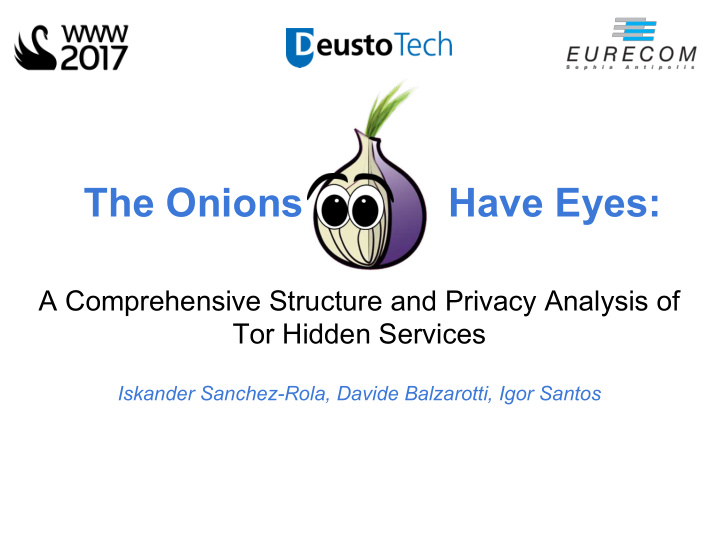



The Onions Have Eyes: A Comprehensive Structure and Privacy Analysis of Tor Hidden Services Iskander Sanchez-Rola, Davide Balzarotti, Igor Santos
Tor Hidden Services • Provides anonymity through the onion routing protocol • Tor has the largest number of users among the different types of Darknets Over 7000 relays • Are used to provide access to different applications Such as chat, email, or websites
Motivation • Previous studies about Tor hidden services have been focused on: Relay Analysis and Routing Analysis (e.g., Sanatinia et al. 2016) Criminal activity (e.g., Ciancaglini et al. 2015, Soska et al. 2015) Some studies about connectivity (OnionScan, 2016 & Deeplight, 2016) Lack of a complete application-level structure analysis like in Surface Web Lack of a complete privacy analysis
Our Work The MOST complete exploration and crawl of Tor hidden services to date • Comprehensive structure and privacy analysis • Not only limited to home pages According to our data, home pages contain only: 11% of links, 30% resources, 21% of the scripts and 16% of tracking • We crawl more than 1.5M of unique onion URLs
Analysis Platform (in a nutshell) The ephemeral and isolated nature of onion sites makes crawling a challenge. 1) We manually collected a .onion URLS comprising 195,748 domains from 25 public forums and directories. 2) We implemented a specific crawler for web Tor hidden services 3) We perform a structure analysis regarding different connection types: links, resources, and redirections 4) We inspect the privacy implications of the connections and perform a measurement study of web tracking in Tor Dark Web
Design of the crawling phase Crawler implementation based on PhantomJS Modified to hide its automatic nature from sites Can deal with script obfuscation (modification of JSBeautifier) Two modes Collection mode Connectivity mode
Crawler - Collection mode Data Retrieved HTML headers , Redirections (+type) HTML content, Scripts and Links Crawling Strategy & Boundaries 3 levels of depth 10 links per each level → Prioritize : keywords & (link size + position) Modifies the “referrer” to mimic user navigation
Crawler - Connectivity mode Retrieved Data Links (all of them: visible or invisible) Not position ones: “#” or files (e.g., pdf, images) Crawling Strategy & Boundaries No limit in depth or links visited Avoid the so called calendar effect: 10,000 URLs per each domain Goal: capture the remaining structure not previously crawled
Size & Coverage Domains Data 198,050 domains gathered → 7,257 were active domains Confirmation of the ephemeral nature of onion sites 3 more crawling attempts (days and month of difference) 81.07% were completely crawled by the collection mode 18.49% were added by the connectivity mode 0.54% contained more than 10,000 URLs
Onion Domains/URL Distribution 46.07% of the domains contained just one URL >80% of the domains less than 17 URLs
Language & Categories - Methodology Languages We use the Google Translate API Categories 1) Translate the HTML plain text with Google Translate API 2) Remove stop words + stemming 3) Model as Bag of Words (Vector Space Model) 4) Clustering process with Affinity Propagation 5) Manual inspection of the clusters to find the category
Language Distributions Language % Domains English 73.28% Russian 10.96% German 2.33% French 2.15% Spanish 2.14% Ranking is similar to the surface web, with the omission of Japanese The ranking is different to other studies (Deeplight)
Category Distributions Category % Domains Directory/Wiki 63.49% Default Hosting Message 10.35% Market/Shopping 9.80% Bitcoins/Trading 8.62% Forum 4.72% Online Betting 1.72% Search Engine 1.30% 15.4% of the domains belonged to more than 1 category
Structure Analysis - Links Highly connected but sparse (>60,000 connections) 10% were complete isolated and not reachable → 90% are
Structure Analysis – Resources and Redirections 82.83% and 84.88% of the nodes are strongly connected Also highly connected but smaller networks of connections than links
Privacy Analysis - Dark-to-Surface Leakage 21% of the sites import resources from the surface Google alone can monitor the 13% of the Tor hidden services
Privacy Analysis - Web Tracking TrackingInspector is used to analyze scripts
Privacy Analysis - Web Tracking - Prevalence
Privacy Analysis - Web Tracking - Specifics Type % Tracking Scripts Statistics 17.10% Stateless Tracking 15.04% Advertisement 10.48% Web Analytics 10.08% Stateful Tracking 7.22% 10% of the tracking scripts were unique 32.50% of the tracking came from surface web
Privacy Analysis - Tracking Hiding techniques • Obfuscated tracking exists in the dark web: 0.61% of the scripts did • Script embedding is highly used (16.28%) and with a large number of techniques, e.g.: dota.js → canvas fingerprinting analytics.js → the usual Google tracking • New technique: intermediate tracking in redirections: 1.67%
We already knew that the hills have eyes...
but we didn’t expect onions to have them too …
but they do... The Onions Have Eyes iskander.sanchez@deusto.es iskander-sanchez-rola.github.io
Recommend
More recommend